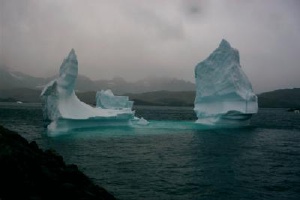Jun 12 2008
The Greenland Ice Sheet is melting faster than previously calculated according to a recently released scientific paper by University of Alaska Fairbanks researcher Sebastian H. Mernild.
 An iceberg in the Tasiilaq harbor in East Greenland in 2005. (Credit: Sebastian H. Mernild)
An iceberg in the Tasiilaq harbor in East Greenland in 2005. (Credit: Sebastian H. Mernild)
The study, published in the journal Hydrological Processes, is based on models using data from the Intergovernmental Panel on Climate Change, as well as satellite images and observations from on the ground in Greenland.
Mernild and his team found that the total amount of fresh water projected to flow from the Greenland Ice Sheet into the North Atlantic Ocean from 2071 to 2100 will be more than double current levels.
Today, the East Greenland Ice Sheet adds 257 cubic kilometers of fresh water to the ocean per year from both melting and iceberg calving. By 2100, those levels are estimated to reach 456 cubic kilometers per year. With land-based runoff factored in, the total fresh water flowing from Greenland into the ocean is estimated to increase from 438 cubic kilometers to 650 cubic kilometers by 2100. The projected increase means that rather than rising at a rate of 1.1 millimeters per year, sea levels would rise by 1.6 millimeters per year.
"The Greenland Ice Sheet mass balance is changing as a response to the altered climatic state," said Mernild. "This is faster than expected. This affects freshwater runoff input to the North Atlantic Ocean and plays an important role in determining the global sea level rise and global ocean … circulation."
Mernild is conducting the research as part of the University of Alaska's International Polar Year efforts. He was appointed a University of Alaska IPY postdoctoral fellow by UA president Mark Hamilton in 2007.